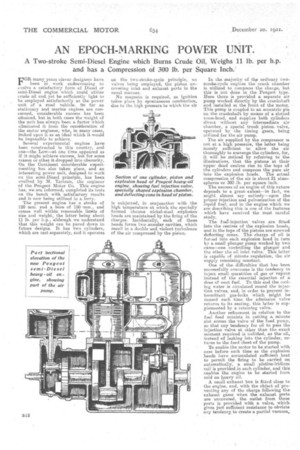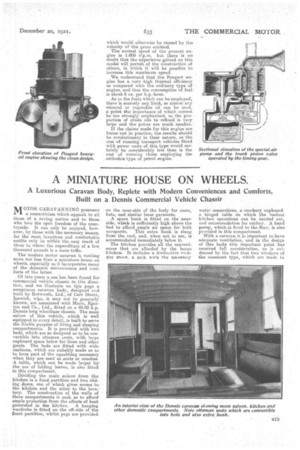AN EPOCH-MARKING POWER UN - IT.
Page 10

Page 11

If you've noticed an error in this article please click here to report it so we can fix it.
A Two-stroke Semi-Diesel Engine which .Burns Crude Oil, Weighs 11 lb. per h.p. and has a Compression of 300 lb. per Square Inch.'
FOR. many. years clever designers have been at work endeavouring to evolve a satisfactory form of Diesel or semi-Diesel engine which could utilize crude oil and, yet be sufficiently light to be employed satisfactorily as the power unit of a road vehicle. So far as stationary and marine engines are concerned, considerable success has been attained, but in both eases the weight of the unit has always been a factor which eliminated it from the consideration of the motor engineer, who, in many cases, looked upon it as an ideal which it would be impossible to aehieve.
Several experimental engines have been constructed in this country, and one—the Low—at one time appeared as if it might achieve succes.s1 but for some reason or other it dropped into obscurity. On the Continent considerable e3sperimenting has also taken place, and an interesting power unit, designed to work on the semi-Diesel principle, has been evolved by M. Tart:cals., the engineer of the Peugeot Motor Co. This engine has, we are informed, completed its tests on the bench with satisfactory results and is now being utilized in a lorry.
The present engine has a stroke of 120 mm. and a bore of 150 •mm., and comes well within reasonable limits of size and weight, the latter being about 11 lb. per h.p., although we understand that this weight can be pared down in future designs. It has two cylinders, which are cast separately, and it operates on the two-stroke-cycle principle, no valves being employed, the piston uncovering inlet and exhaust ports in the usual manner.
No magneto is required, as ignition takes place by spontaneous combustion, due to the high pressure to which the air is subjected, in oonjunction with the high temperature at which the specially formed chrome nickel-steel explosion heads are maintained by the firing of the charges. Incidentally, each of these heads forms two annular cavities, which result in a double and violent turbulence of the air compressed by the piston.
In the majority of filo ordinary twostroke-cycle engines the crank chamber is utilized to compress, the charge, but this is not done, in the Peugeot type. Here there is provided a separate air pump worked directly by the crankshaft and installed at the front of the motor. This pump is coupled to an eccentric pin on the crankshaft by means of a slotted cross-head, and supphes both cylinders direet -without any intermediate air chamber, a special trunk piston. valve, operated by the timing gears, being utilized for the air pump.
The air supplied by the compressor is not at a high pressure, the latter being merely sufficient to allow the air thoroughly to scavenge the cylinders, for, it will be rroticed by referring to the illustrations, that the pistons at their upper dead centres rise to the tops of the cylinders and compress the pure air into the explosion heads. The actual compression of the air is. about 21 atmospheres or 300 lb. per square inch.
The success of an engine of this nature depeads to a greateitent—in fact, we might almost say entirely—upon the prbper injection and pulverization of the liquid fuel, and in the engine, which we are describing this is one of the features which have received the most careful study. The fug-injection valves are fitted into the centres of the explosion heads, and in the tops of the pistons are screwed deflecting cones. The charge of oil is forced into each explosion head in turn by a small plunger pump worked by two cares—one controlling the plunger and the other the oil inlet valve. This latter is capable of minute regulation, the air supply remaining constant.
One of the difficulties that has been successfully overcome is the texcl•ency to inject small quantities of gas or vapour instead of the essential injection of a dose of neat fuel. To this end the cooling water is circulated round the injection valves, and, in order to prevent intermittent gas-locks which might be caused each time the admission valve returns to its seating, this latter is supplemented by a retaining valve.
Another refinement in relation to the fuel feed consists in cutting a minute slot across the valve of the feed pump, so that any tendency for oil to pass the injection valve at other than the exact moment required is nullified, as theoil, instead of leaking into the cylinder, returns to the feed chest of the pump.
-To enable the motor to be started with e-see before such time as the explosion heads have accumulated sufficient heat to permit the firing to be carried on automatically, a small platiniceiridium coil is provided.in each cylinder, and this enables the engine to be started from cold on heavy oil.
A small exhaust box is fitted close to the engine, and, with the object of preventing any of the charge following the exhaust gases when the exhaust ports are uncovered, the outlet from these ports is provided with a valve, which gives just sufficient resistance to obviate any tendency to create a partial vacuum,
which would otherwise be caused by the velocity of the gases emitted.
The normal speed of the present engine is 1.000 ep.m. but there is no doubt that the-experience gained on this model will permit of the construction of others, in which it will be possible to increase this maximum speed.
We understand that the Peugeot engine has a very high thermal efficiency as compared with the ordinary type of engine, and that the consumption of fuel is about 6 oz. per h.p.-hour.
As to the fuels which can be employed, there is scarcely any limit, as almost any mineral or vegetable oil can be used, a point the importance of which cannot be too strongly emphasized, as the proportion of crude oils to refined is very large and the prices are much smaller.
If the claims made for this engine are borne out in practice, the results should be revolutionary in their nature, as the cost of running transport vehicle& fitted with power units of this type would certainly be considerably less than is the cost of running those employing the orthodouo type of petrol engine.
































